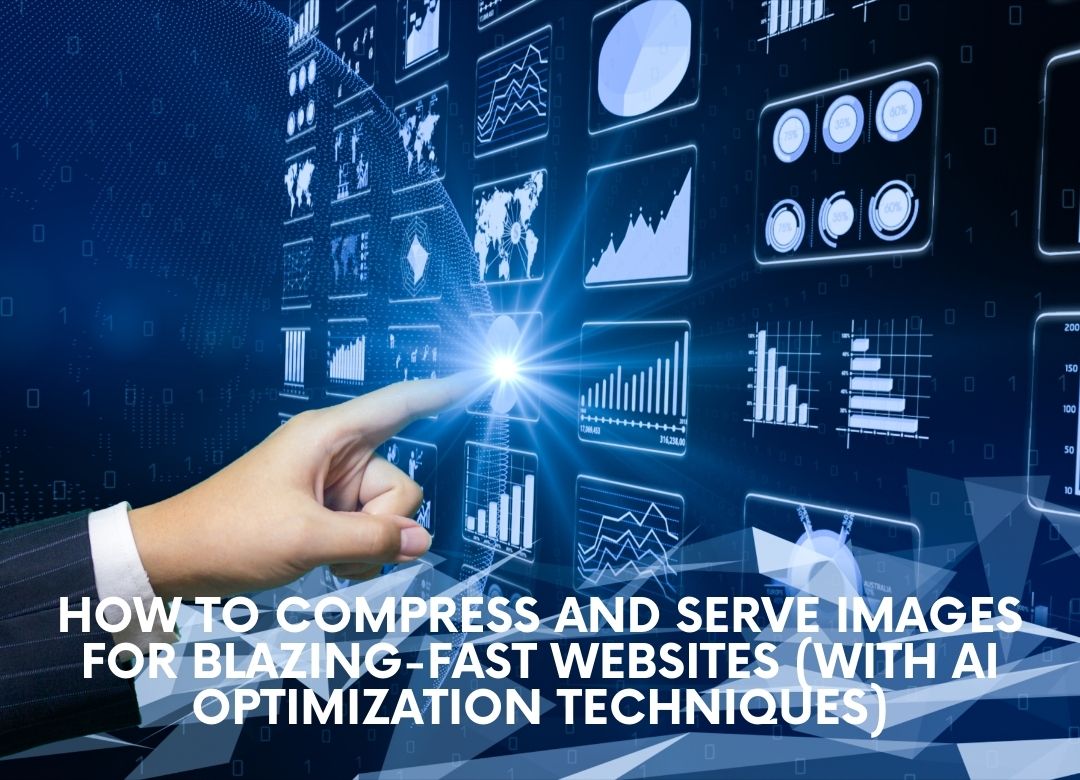Why, How, and When to Compress and Delivery Images to Make Websites Incredibly Fast (Including AI-powering Methodologies) Nowadays in a world full of digital technologies, speed is not merely an extra feature, but a necessity. Regardless of whether you maintain a blog account, an e-commerce shop or a corporate site, sluggish pages will hurt user interaction, sales and search engine optimization. Slow websites!? One of the key causes of it is because of? Unoptimized images.
With image files taking up most of a web page’s weight, even a few large images can really hurt performance. This detailed guide will show you how to properly compress and serve images and, more importantly, how to use AI-based image tools to enhance optimization, improve SEO and provide a better user experience.
Why Image Optimization Matters
Images make up over 60% of the total weight of an average web page. If you don’t optimize them, it can slow down your site and that can lead to big problems.
Here’s why optimizing images is critical:
- Reduce load time: Slow site decreases the bounce rate and makes visitors satisfied.
- Increase SEO: Google considers the speed of pages when ranking websites and optimized images can be of great help.
- Conserve bandwidth: Small display images consume less data, and this is important to both the server expenses as well as mobile consumers.
- Increase conversions: There is evidence that faster websites have more conversions JFIF to JPG at every second.
In short, it is mandatory to optimize images. It is important in making high performance websites.
Step 1: Choose the Right Image Format
Selection of an image format can actually alter the quality and the size. Each format has its own advantages and best situations to use.
| Format | Best Use | Pros | Cons |
|---|---|---|---|
| JPEG / JPG | Photographs, detailed images | Small file sizes | Lossy compression |
| PNG | Icons, logos, images needing transparency | Lossless quality | Larger file sizes |
| WebP | General use on the web | Smaller files, transparency, modern compression | Not supported in legacy browsers |
| AVIF | Cutting-edge optimization | Extremely efficient, high quality | Still limited browser support |
| SVG | Logos, illustrations, UI elements | Fully scalable and editable | Not for photos |
AI Recommendation:
With the help of AI, compressors, such as Cloudinary Smart Format Conversion or ImageKit.io smart optimization, can make things faster and more compatible without manual work by automatically choosing the best format to extent based on the situation, device, and browser.
Step 2: Compress Your Images (with AI Assistance)
Compression makes file sizes smaller without really affecting the quality of the images. There are two kinds:
- Lossy: Takes away unnecessary data (JPEG, WebP).
- Lossless: Compresses without losing any details (PNG, lossless WebP).
Manual Tools:
- Online: TinyPNG, Squoosh, Compressor.io
- Desktop: ImageOptim (Mac), RIOT (Windows), GIMP
- CLI (For Developers): imagemin, jpegoptim, cwebp, avifenc
AI Tools:
New AI tools do more than just regular compression; they understand what’s in the image and its context.
- Imagify AI: Changes compression based on what’s important in the image.
- Cloudinary AI: Sees different parts of the image and uses smart compression.
- ShortPixel AI: Smartly chooses the compression and the lowest size with the highest quality.
Best Practice: Be sure to compress your images every time before you upload. An image of 1MB can usually be reduced to less than 200KB to the naked eye and AI software can do it automatically and en masse.
Step 3: Resize Images for Your Layout
Uploading huge images that only show up in a tiny part of your layout is a waste.
Tips for Resizing:
- Scale image sizes to suit their container on layout.
- Make different variants (mobile, table, desktop).
- With srcset and
, you can give every device the correct size.
AI Enhancement:
With AI services such as Akamai Image Manager or ImageKit.io, the layout requirements and device types can be automatically determined to provide you with just the right resized images without you having to worry about resizing them anyway.
Step 4: Use Responsive Images (srcset + sizes)
The presently available HTML allows you to deliver variants of image size according to screen size and resolution. This improves how fast web resources are loaded as it would not attract large images to be loaded into a small screen.
<img src="image-small.jpg" srcset="image-small.jpg 480w, image-medium.jpg 800w, image-large.jpg 1200w"
sizes="(max-width: 600px) 480px, 800px" alt="A fast-loading website">Combine with Lazy Loading:
Responsive images and lazy loading ensure that you only deliver that which the consumer requires, exactly when they require it.
Step 5: Enable Lazy Loading
One does not have to load all the pictures on the page when only a proportion of the users may not scroll to the bottom of the page to view them.
Native HTML Lazy Loading:
<img src="image.jpg" loading="lazy" alt="..." />JavaScript Lazy Load Libraries:
- lazysizes
- Lozad.js
AI Tip:
Such AI tools as NitroPack and Cloudflare Images are capable of auto-discovering when and how to lazy-load images in the best performing manner.
Step 6: Serve Images via a CDN
A Content Delivery Network (CDN) ensures your pictures are distributed by a server nearest to the visitor and this truly aids in reducing site loading speed.
Benefits:
- Global image caching
- Automatic compression and WebP/AVIF conversion
- Real-time image resizing
- Bandwidth savings
Trusted Image CDNs:
- Cloudinary
- ImageKit
- Cloudflare Images
- Fastly
- Akamai Image Manager
Pro Tip: Try using AI-enhanced CDNs like Cloudinary to automatically optimize images based on how users behave and what devices they are using.
Step 7: Smart Image Caching
Caching enables browsers to store the images on their computers when accessed, such that the people do not need to call them again with the visit of each user.
Use Proper HTTP Headers:
Cache-Control: public, max-age=31536000, immutable
CMS Users:
Use plugins like:
- WP Rocket
- LiteSpeed Cache
- W3 Total Cache
AI Use Case:
AI-powered caching systems, such as those from NitroPack or Quic.cloud, can guess what visitors will do and preload or delay images to make everything faster and more efficient.
Step 8: Audit & Monitor Image Performance
A complete image optimization process must include performance testing and audits.
Essential Tools:
| Tool | Use |
|---|---|
| Google PageSpeed Insights | Analyze performance, suggest image optimizations |
| GTmetrix | Deep performance analysis |
| WebPageTest.org | Real-world test scenarios |
| Lighthouse (Chrome DevTools) | Audit tools built into your browser |
| Screaming Frog SEO Spider | Crawl site and analyze image sizes, alt text and more |
Best Practice: Ensuring regular audits and Image update as the technology of the browsers evolve especially in terms of formats and compression techniques.
Bonus: Automate with AI & CI/CD
Scaling Large or changing websites requires automation.
For Developers:
You can add image optimization to your CI/CD pipeline by using::
- imagemin
- gulp-image
- webpack-image-loader
You can also script AI-based workflows using:
- Cloudinary’s API
- ShortPixel’s API
- Kraken.io API
For CMS/No-Code Users:
Install automation plugins:
- EWWW Image Optimizer
- ShortPixel
- Imagify
- Robin Image Optimizer
They assist in compression, conversion and resize of images when you upload them and they allow you to optimize your whole media library in a batch.
Final Thoughts
Minimizing a file size is no longer the only objective of optimizing an image; the goal is now to wisely and effectively dispense this visual content with the quality, speed and interest that holds across all platforms and devices.
With automation and AI, the current delivery of images has evolved such that your site could transform itself on the fly to accommodate your visitors according to their requirements.
By implementing these strategies, you can:
- Significantly cut down page load time
- Boost search engine rankings
- Provide high-quality images on every device
- Enhance conversions and engagement
- Save time with AI-powered automation

Sandeep Kumar is the Founder & CEO of Aitude, a leading AI tools, research, and tutorial platform dedicated to empowering learners, researchers, and innovators. Under his leadership, Aitude has become a go-to resource for those seeking the latest in artificial intelligence, machine learning, computer vision, and development strategies.


